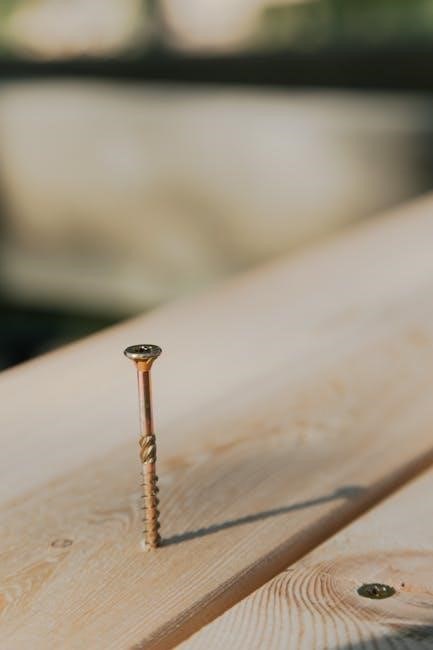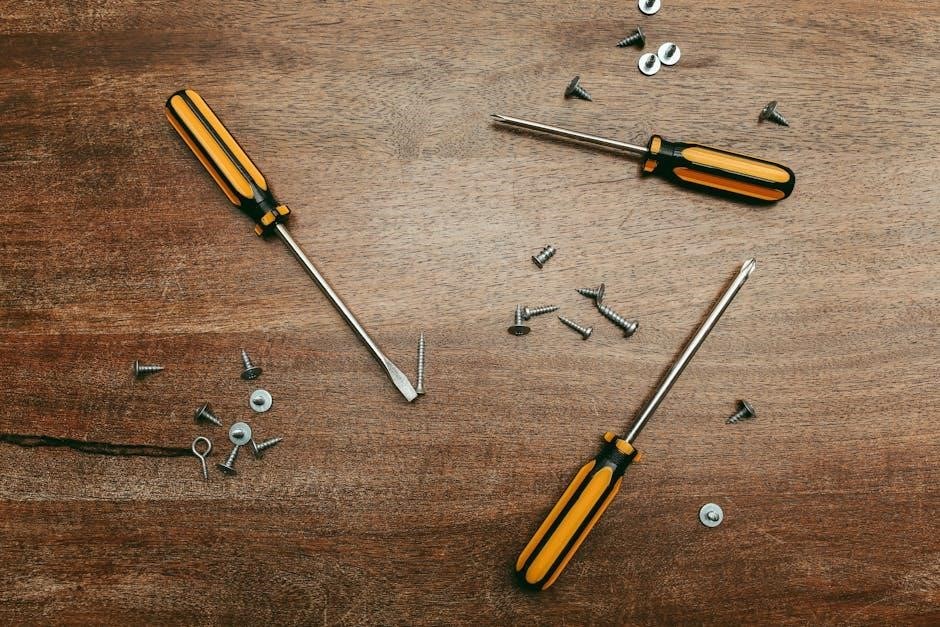Understanding wood screw sizes is crucial for ensuring strong joints and preventing wood splitting. This guide covers diameter, length, thread count, pilot holes, and head types to help you choose the right screws for your project, ensuring optimal hold and durability in various woodworking applications.
Understanding Wood Screw Measurements
Wood screw measurements are critical for proper fitment and performance. Major thread diameter, length, and thread count are key factors. Screws are sized by gauge, with larger numbers indicating smaller diameters. For example, a size 0 screw has a diameter of 1/16 inch, while size 3 measures 3/32 inch. Accurate measurements ensure the screw fits securely without causing damage, making them essential for successful woodworking projects.
Importance of Choosing the Right Screw Size
Choosing the right screw size is essential for proper fitment and performance. A screw that is too small may not hold securely, while one that is too large can split the wood. Correct sizing ensures a solid hold, prevents damage, and enhances durability. Using the wrong size can lead to loose joints or project failure, making accurate selection critical for successful woodworking outcomes.

Wood Screw Diameter and Thread Size
Wood screw diameter and thread size are critical for ensuring proper fit and strength. Measurements are often charted in decimal or fractional sizes, affecting joint integrity and material compatibility.
Major Thread Diameter Chart
The major thread diameter is the largest diameter of the screw thread, measured at the outer edge. This measurement is crucial for determining the screw’s strength and fit. Charts typically list sizes from 0 to 3, with decimal and fractional equivalents (e.g., size 0 = 0.060″, 1 = 0.073″). Referencing these charts ensures proper screw selection for various woodworking projects, preventing over- or under-sizing, which can compromise joint integrity and material compatibility. Printable charts are often available for quick reference, making it easier to match screws to specific tasks and materials, ensuring optimal results in construction and assembly processes. Always cross-check measurements before drilling or driving screws to avoid errors and ensure a secure, lasting hold in wood surfaces. This guide provides a comprehensive overview of major thread diameters, helping users understand how to interpret and apply size charts effectively in their projects. By following these guidelines, woodworkers can achieve professional-grade results with minimal effort and maximize the durability of their creations. The importance of accurate measurements cannot be overstated, as they directly impact the final product’s quality and structural integrity. Using the right tools and resources, such as detailed charts and conversion guides, ensures that every screw used is appropriately sized for its intended purpose, reducing the risk of failure and improving overall satisfaction with the finished work. Whether working on furniture, decking, or other woodworking tasks, understanding major thread diameters is essential for achieving success. This section provides a clear and concise reference for selecting the correct screw size, eliminating guesswork and saving time during the project planning phase. With this knowledge, users can confidently choose screws that meet their specific needs, ensuring both functionality and aesthetics in their woodworking endeavors. The major thread diameter chart serves as a foundational tool for anyone working with wood screws, offering a straightforward way to navigate the complexities of screw sizing and selection. By adhering to the guidelines outlined in this chart, woodworkers can avoid common pitfalls and produce high-quality, long-lasting results. The chart’s inclusion of both decimal and fractional measurements caters to a wide range of users, from hobbyists to professionals, ensuring universal accessibility and applicability. This resource is indispensable for anyone seeking to master the art of woodworking and achieve precision in their craft. The major thread diameter chart is a testament to the importance of attention to detail in woodworking, providing a reliable framework for screw selection that translates to superior outcomes in every project. Understanding and utilizing this chart effectively empowers woodworkers to make informed decisions, elevating their work from ordinary to extraordinary. In conclusion, the major thread diameter chart is an indispensable tool for anyone working with wood screws, offering a clear path to selecting the right screw size for any application and ensuring the best possible results in their woodworking projects.
Thread Count and Its Impact on Holding Power
Thread count, measured in threads per inch (TPI), significantly affects a screw’s holding power. Higher TPI increases surface contact, enhancing grip in wood. However, overly fine threads may reduce strength, while coarse threads can split wood. Proper thread count selection balances holding power and material compatibility, ensuring secure joints without compromising wood integrity. Always consider wood type and project requirements when choosing TPI for optimal performance.

Pilot Hole Sizes for Wood Screws
Pilot holes are essential for avoiding wood splitting and ensuring proper screw alignment. Correct sizing depends on screw diameter and wood type. Use a chart to match screw size with the appropriate drill bit diameter for precise, damage-free installation and optimal results in woodworking projects.
How to Choose the Right Drill Bit Size
Selecting the right drill bit size for pilot holes ensures proper screw alignment and prevents wood splitting. Match the drill bit diameter to the screw’s major thread diameter using a size chart. For example, a #6 screw typically requires a 3/32″ drill bit. Always consider wood density and screw type to avoid over- or under-drilling, ensuring a secure and professional finish in your woodworking projects.
Consequences of Incorrect Pilot Hole Sizes
Incorrect pilot hole sizes can lead to wood splitting or screws not holding properly. Oversized holes cause screws to be loose, reducing holding power, while undersized holes may result in screws breaking or wood cracking. Proper sizing ensures secure joints and prevents material damage, making it essential to use a drill bit size chart for accurate results in woodworking projects.
Head Types and Their Measurements
Wood screws come in flat (countersink) and round (pan) heads, each with specific measurements. Flat heads sit flush, while round heads protrude slightly, affecting their application and fit.
Flat (Countersink) vs. Round (Pan) Head Screws
Flat head screws are measured by total length and designed to sit flush with the wood surface, ideal for countersinking. Round head screws are measured from underneath the head and protrude slightly, offering a decorative or functional pan-shaped design. Choosing the right head type depends on the desired appearance and application requirements of your project.
Head Diameter and Screw Length Measurements
Head diameter varies between flat and round head screws, with flat heads designed for countersinking. Screw length is measured from the tip to the head’s underside for round heads and overall for flat heads. Accurate measurements ensure proper fit and strength, with charts providing precise gauge-to-diameter and length correlations for optimal project outcomes.
| Gauge No. | Major Thread Diameter (in) | Head Diameter (in) | Length Range (in) |
|---|---|---|---|
| 6 | 0.138 | 0.250 | 1/2–3 |
| 8 | 0.164 | 0.312 | 1/2–3 |
Materials and Strength of Wood Screws
Wood screws are commonly made from carbon steel, stainless steel, or brass, with coatings like zinc or galvanized for corrosion resistance. Strength varies by material and hardness, ensuring durability and holding power in woodworking projects.
Common Materials Used for Wood Screws
Wood screws are typically made from carbon steel, stainless steel, or brass. Carbon steel is durable and cost-effective, while stainless steel offers superior corrosion resistance, ideal for outdoor projects. Brass screws are often used for decorative purposes due to their attractive appearance. Additionally, coatings like zinc or galvanized finishes enhance corrosion resistance without compromising strength or durability.
Hardness and Strength Tolerance in Screws
Wood screws are manufactured with specific hardness and strength tolerances to ensure reliability. Typically, screws are made from carbon steel, with hardness measured on the Rockwell scale. Higher hardness levels enhance resistance to stripping and wear. Strength tolerance is critical for load-bearing applications, ensuring screws can withstand stress without deformation. Material quality and manufacturing standards directly impact these properties, making them vital for durability and performance in woodworking projects.
Wood Screw Length and Gauge
Gauge size determines the screw’s shank thickness, affecting its holding power. Lower gauges (thicker screws) suit dense woods, while higher gauges (thinner screws) are ideal for softwoods. Proper gauge selection ensures optimal joint strength and prevents splitting.
How Screw Length Affects Joint Strength
Screw length significantly impacts joint strength. Longer screws provide better holding power, especially in thicker materials. The screw should fully engage both pieces without protruding excessively. Proper length ensures even weight distribution and reduces the risk of splitting; Too short, and the joint may weaken; too long, and it might cause wood to splinter.
Gauge Size and Its Role in Screw Selection
Gauge size determines the screw’s thickness, affecting its holding power. Higher gauge numbers indicate thicker screws, offering greater strength for dense materials. Proper gauge selection ensures optimal performance without overloading the wood, preventing splitting. Matching the gauge to the project’s demands is vital for durability and structural integrity in woodworking applications.
Applications of Different Wood Screw Sizes
Wood screws come in various sizes to suit different applications. From furniture making to decking, selecting the right screw size ensures stability and prevents damage. Proper sizing enhances performance and longevity in woodworking projects.
Choosing the Right Screw for Your Project
Selecting the appropriate wood screw size involves matching the screw to the wood type, thickness, and intended use. Consider the load-bearing requirements and environmental conditions. Proper screw size ensures optimal hold without splitting the wood, enhancing joint strength and durability. Always choose screws that align with your project’s specific needs to achieve professional results and long-lasting performance.
Popular Wood Screw Sizes and Their Uses
Popular wood screw sizes include #6, #8, and #10, each serving specific purposes. #6 screws are ideal for thin wood and lightweight projects, while #8 screws are versatile for general woodworking. #10 screws are best for heavy-duty applications. These sizes are widely available and suitable for most woodworking needs, making them favorites among woodworkers for their reliability and performance.
Drilling and Installation Tips
Use pilot holes to avoid wood splitting and ensure proper screw alignment. Countersink holes for flush screw heads, and keep drill bits sharp for clean, precise drilling.
Best Practices for Drilling Pilot Holes
Drilling pilot holes is essential for preventing wood splitting and ensuring accurate screw placement. Use a drill bit slightly smaller than the screw’s major diameter. Maintain sharp drill bits for clean cuts. Drill slowly and steadily to avoid overheating the bit. Pre-drill guide holes for large screws or hardwoods. This ensures a precise fit and minimizes the risk of damage to the material.
Techniques for Avoiding Wood Splitting
To avoid wood splitting, always drill pilot holes and countersink for large screws. Ensure screws match the material’s thickness and type. Avoid overtightening and consider wood grain direction. Use sharp tools and maintain even pressure. Pre-drilling guide holes in hardwoods or near edges enhances stability and prevents damage, ensuring secure and durable joints every time.

Wood Screw Size Chart and Conversion
This chart provides decimal, fractional, and metric conversions for wood screw sizes, ensuring accurate measurements. It simplifies size comparisons and streamlines project planning with precise data.
Decimal, Fractional, and Metric Conversions
Decimal, fractional, and metric conversions are essential for accurate wood screw sizing. This chart aligns US measurements with global standards, ensuring compatibility. For instance, a #6 screw is 0.138″ (1/8″), while its metric counterpart is 3.5mm. These conversions prevent size mismatches, enabling precise drilling and installation across projects, whether using imperial or metric systems. This ensures consistency and reliability in woodworking applications worldwide.
Printable Size Chart for Quick Reference
A printable wood screw size chart provides a quick reference guide for decimal, fractional, and metric measurements. It includes screw diameters, lengths, and pilot hole sizes, ensuring easy access to critical dimensions. This chart is invaluable for woodworking projects, allowing rapid selection of the correct screw size without guesswork, saving time and reducing errors. Print it for workshop convenience.

Common Mistakes to Avoid
Overlooking screw length and gauge can lead to weak joints and wood splitting. Ignoring material strength and head type often results in poor performance and project failure.
Overlooking Screw Length and Gauge
Ignoring screw length and gauge can compromise joint strength and material integrity. Using screws too short may fail to secure materials properly, while overly long screws can protrude or split wood. Always measure accurately and consult size charts to ensure proper fit and durability in your woodworking projects.
Ignoring Material and Head Type
Ignoring material and head type can lead to poor hold, wood splitting, or corrosion. Using incorrect materials may not suit environmental conditions, while wrong head types can leave screws protruding. Always consider screw application and consult size charts to prevent such issues and ensure proper durability in woodworking projects.
Tools Needed for Wood Screw Projects
Essential tools include drill bits for pilot holes, screwdrivers for driving screws, and measuring tools for accurate screw selection. These ensure proper installation and project success.
Essential Drill Bits and Screwdrivers
High-quality drill bits, such as twist bits for pilot holes and countersink bits for flush surfaces, are vital for precise screw installation. Screwdrivers, including flathead and Phillips types, ensure proper driving without stripping screw heads. These tools are fundamental for achieving secure joints and professional finishes in woodworking projects, preventing wood splitting and ensuring durability.
Measuring Tools for Accurate Screw Selection
Precise measurement is key to selecting the right screws. Calipers ensure accurate thread diameter and length measurements, while screw gauge gauges help determine thread pitch and size. Tape measures and depth gauges are essential for verifying screw length and pilot hole depth. These tools ensure proper fitment and prevent installation errors, guaranteeing secure joints and professional results in woodworking projects.
